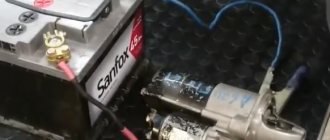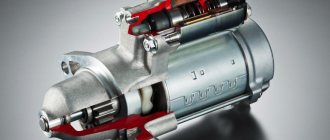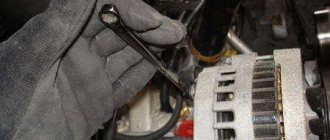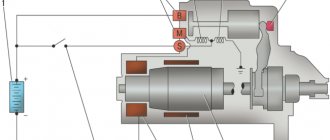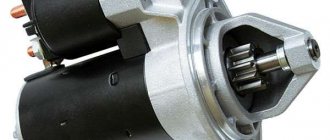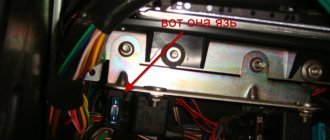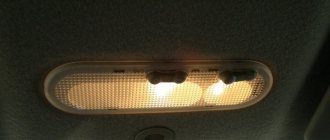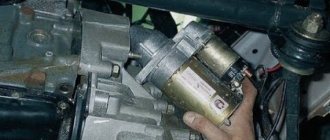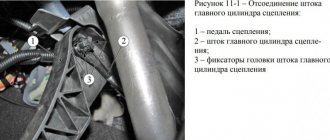Lada Vesta has been produced at AvtoVAZ facilities since November 2015. The article selects all the weaknesses of Vesta that have been identified by car owners at the moment. The line of power units consists of three gasoline engines: 11189, 21129, HR16DE-H4M. The latter is an imported engine produced by the Renault-Nissan alliance.
It is installed on such Nissan car models as: Note, Qashqai, Juke, Tiida. The total share of Russian-made spare parts is 20%. Reviews from West owners speak positively about the car, but there are still some shortcomings that may await you soon after purchase and active use.
Our infographics contain the most current and most common Vesta diseases, so this information will help owners of the new model prepare for possible problems and find out the weak points of the Lada Vesta.
Why Lada Vesta/XRAY does not start, causes of malfunctions
To start the engine, it is necessary to ensure the appearance of a fuel-air mixture in the engine cylinders, which will be ignited by an electric spark at the right moment. Problems with starting the engine occur if one or more elements of the vehicle systems malfunction. Next, we will tell you what could be the reason for the poor starting of the VAZ 21127 (1.6l, 106hp), 21179 (1.8l, 122hp), H4M (1.6l, 110hp) engine on Lada Vesta and XRAY.
The engine does not start, the starter does not turn
- The battery is discharged. Charge, replace with a new one, or install a known working one for testing.
- Poor contact at battery terminals. Clean oxidized terminals and tighten if necessary.
- Malfunction in the starter electrical circuit. Check starter wiring.
- Starter drive parts are faulty. Check the starter (temporarily install a known working starter) and repair if necessary.
- The starter traction relay is faulty. Close the starter nuts with a screwdriver; if the starter spins, the traction relay should be replaced with a new one.
- The starter motor (armature, windings, brush assembly) is faulty. Check the starter (temporarily install a known working starter) and repair if necessary.
- The ignition switch is faulty. Check and repair if necessary.
- The engine or attachments are jammed. Check the rotation of the crankshaft, pump and generator pulley. Make repairs if necessary.
Causes of problems
It is worth considering several options for reasons why the Lada Vesta may not start:
- The starter does not work or does not work correctly.
- Poor fuel mixture.
- Violation of the structure and function of the timing belt.
- Malfunction of electrical sensors (idle speed or temperature).
- Malfunctions in the ignition system (plugs, ignition coils and circuits).
- State of relays and fuses.
- Quite a bad contact in the electrical circuit of the engine power supply and the operation of the control system.
- Inadequate operation of the immobilizer.
- Problems with the battery - it is completely discharged or there are problems with the contacts.
- Malfunction in the alarm system - blockage in the control system.
Based on the above problems, in the winter season the first five reasons are quite common, due to which the car begins to “triple” or stall.
Starter problems and solutions
The starter may not work correctly or may not work at all due to a discharged battery - there is no supply of electrical impulses, then the starter will not crank.
If there is a problem with the battery, you should replace it with a new one. Before installation, make sure whether the battery is working or not. If the owner of a Lada Vesta is confident that the battery is working properly, charge it and check it. If the indicators are negative, replace the battery.
The second reason for poor starter cranking is unreliable contacts in the electrical circuit. If the terminals are dirty, clean and recheck. It is also necessary to check the integrity of the starter wiring. If there are defects, replace them.
It is possible that there is a problem with the starter itself. If it is faulty, the best option in this situation is to replace it with a proven new starter. If there is not enough money to purchase a new starter, repair it.
Problems in its operation can be: poor relay traction, weak fastening, malfunctions in the structure of the armature, windings, brush units. If the problem is in the fastening itself, tighten the nuts with a screwdriver. If the starter continues to spin, replace the traction relay.
The starter turns, does not start well or does not engage
- There is no gasoline in the fuel tank.
- The battery is discharged, the crankshaft rotates too slowly. Charge or replace the battery.
- Increased crankshaft rotation resistance. In cold weather, engine oil froze.
- Battery terminals are oxidized or not tightened sufficiently. Strip and tighten.
- The problem is in the car's fuel system. There is no required fuel pressure, tightness, or the injectors are faulty. Check the fuel pump, fuel pressure regulator, fuel line and injector operation.
- The timing belt (gas distribution mechanism) is broken. Replace the belt.
- The timing belt has slipped several teeth. Check that the marks match. Tension and install the belt correctly.
- Ignition system malfunctions. The electrical circuit of the ignition coils, high-voltage wires, and spark plugs are faulty. Check the wiring, spark plugs, the order of connecting high-voltage wires and, if necessary, replace faulty parts.
- The crankshaft position sensor (CPS) or its circuit is faulty. Check and replace.
- The coolant temperature sensor (DTOZH) is faulty. Check and replace.
- The idle air control (IAC) or its circuits are faulty. If the engine starts with the gas pedal pressed and stalls when the gas pedal is released, then the sensor is faulty.
- The fuse is blown or the main relay of the control system is faulty. Check fuses and relays.
- Unreliable connection of electrical circuits of engine control and power supply systems. Check all ground attachment points, connector connections, and reliability of contacts in the blocks.
- Insufficient compression in the cylinders.
- The engine control system is faulty. Run diagnostics.
- The immobilizer blocks the engine from starting.
- Air leak into the intake tract. Inspect the joints and fittings of the hoses and clamps.
10000km or review about veste
Hello, friends. I decided to write my opinion about the Lada Vesta comfort package that I bought in December 2016. I didn’t write it right away, because the opinion must be sustained, then it will be more objective, without unnecessary emotions. The opinion about the car is my own, I do not impose it on anyone and I do not encourage discussions and disputes. The reason for purchasing the Lada Vesta was the price + ground clearance compared to its competitors. The car was purchased for 616 rubles. in Lada-Berezovsky, Yekaterinburg. The managers of the car dealership are polite, the purchase process was at the highest level (we'll see how things go with warranty service, but I feel it is simply necessary). Once I got into the car, I began to adjust the steering wheel and seat (my height is 188 cm), no matter how I tried to adjust it, but the ignition key rested on my knee. In order not to turn the switch key out with my knee, I used a spare key (if I turn it out like that, it’s cheaper). After wishing the car dealership a safe journey, I got into the car and turned the key to the “starter” position. Out of habit, I turned it back, but the starter, after turning the engine, did not start it, the dealership manager even tensed up. I got used to the Fiat starting with half a turn. When starting a Vesta, you need to turn the starter, this is its peculiarity (why is that so?). There was about 0 liters of gasoline in the car from the passenger compartment. Having found out where the nearest gas station was, arriving at it at minus 22 degrees Celsius, I had to rattle around at the gas station for an hour until the tank drained (I was nervous about whether I would stall or not), luckily I didn’t stall. I refueled and set off on a 150 km journey. home. While driving on the highway, I paid attention to the car’s behavior on the highway - the control at speed is exemplary among the cars I have driven before (everyone talks and writes about this, and I will say it too). We will not announce the consumption, since the figure is not an indicator of operational parameters, and it very much depends on the driving style. The noise of the engine and the howl of the gearbox (yes, it is quieter and even nobler, but it is there and that’s all) reminded me very much of my youth and ownership of a VAZ 2112; blindfolded, I would recognize the tenth family by the noise. Arriving home and opening the hood, I was surprised to see there was snow under the hood (there was a lot of snow on the way), and there was ice on the crankcase protection (the snow melted and froze). The hood itself was not adjusted and rattled in the closed position (the hood buffers were screwed in deeply). The side rear-view mirrors are huge, you can see everything, the interior mirror is not enough, and the rear window opening is not large, so it will do (there are cars without interior mirrors). The salon is huge, really huge, it’s relatively quiet, the stove heats up normally, and the windows practically don’t freeze. At home, I spent a long time adjusting the seat and steering wheel so that the key was not opposite the knee, the result is that I’ve been driving for two months now, unusually reclining, the key is still intact (you don’t need to adjust the car to suit you, but adapt yourself to the car if you’re tall). When operating in frosts below minus 17 degrees Celsius, a knocking sound is heard from the front suspension for the first 5-10 kilometers (as I understand from the shock absorbers, they freeze, Murzilka warns that this is not a malfunction), as if someone is hitting the bottom with a hammer. This has never happened on any car before (we need to start at some point), and in the cold the suspension is stiffer, rougher, but the knocks... And you can’t show it to the dealer, everything is described in the manual - it’s allowed. It got warmer, the knocking disappeared, it seemed like I started to enjoy the car, as the snow began to melt (early spring) and after a short drive through puddles the bushings began to grunt on large uneven areas or bumps. Driving the car on the highway is still good and pleasant (something needs to be done with replacing the bushings; at the time of writing, no decision has been made). You get less tired from a long drive than from the previous “Soviet” automobile industry, but AvtoVAZ has room to grow. By the way, on cars before this, the seats were adjusted with “twisters,” which made it possible to adjust them while driving; with the “West” lever adjustment on the go, I don’t risk it. When driving around the city, and even on rough terrain, the brain endures (it just infuriates) three or four layers of very soft cotton wool wrapped around the gas pedal. Let me explain: when you accelerate (move off) - you wait for a reaction to the pressure, release the clutch and ..., there is not enough gas (the cotton wool is wrinkled, but gas is not added), the car either nods and drives or stalls. Well, okay, when there is a flat surface, but if there are holes and bumps under the car, then the feeling of “dosing” of gas is simply necessary, but there is none. AvtoVAZ, someone seemed to voice something similar, we need to do something about it, this is not normal. But as time goes on, the cotton wool on the pedals is slowly peeling off (I’m just getting used to applying a little more gas at a certain clutch position), but before this, this didn’t happen on other cars. People praise Vesta’s brakes, but they just exist, and there’s nothing to add. I've seen better brakes (not on our cars), and in addition they whistle in the cold. The clutch is distinct, soft, and if AvtoVAZ did it, then let’s say so (well done). I also liked the engine in the VAZ 2112, here it became better, they added traction at the bottom, it feels like the engine has potential. Switching the gearbox - AvtoVAZ has to work and work on it... but better than on the classics (okay, it’s not the first time we’ll get used to the gearbox ourselves). The trunk is large, the trunk lid closes gracefully and very easily, the gap between the trunk and the rear window is huge. This winter we overwintered, and next winter we’ll see whether the clogged snow will irritate us or not (on the Fiat Albea there is no gap at all, it was so annoying that the ice would either freeze the lid or it would interfere with slamming (but nothing did)). The doors open and close normally, but there is a real lack of clear intermediate door locks; there are simply no existing locks. I warn passengers traveling with me for the first time about the need to hold the door when opening them so that the “gate” does not get torn out by the wind. MMC understands that it’s not a leader, but it has everything you might need (bluetooth, Wi-Fi, parking sensors, navigation, radio, ...), it’s quite worthy, it’s quite satisfactory. The buttons on the steering wheel are simply classy, convenient, and their backlight is very useful. I used the cruise, but I didn’t experience any special emotions, it’s good. It is more economical to drive without a cruise, since the cruise very clearly monitors the set speed, without using the inertia of the car (it slows down when going uphill, and adds speed uphill). I understand that famous manufacturers won’t be able to create an ideal car right away, the main thing here is not to stop the evolutionary processes of improvement, I’m afraid that the crisis will set priorities for all of us and not in a way that is better for the consumer. There are plans to install a towbar by summer, an alarm system, and covers.
Poor starting when cold or no starting at all
- The battery is discharged, the crankshaft does not rotate fast enough. Charge or replace the battery.
- The reason is in the car's fuel system. There is water in the tank or lines. Remove water. Either the gasoline is bad or of poor quality, change the gas station.
- The coolant temperature sensor (DTOZH) of the engine management system is faulty.
- The idle air control (IAC) or its circuits are faulty. If the engine starts with the gas pedal pressed and stalls when the gas pedal is released, then the sensor is faulty.
- The ignition module is faulty. Check, replace with a new one.
- The oxygen sensor (lambda probe) is faulty.
- Fuel injectors are leaking. Check and replace if necessary.
- The engine control system is faulty. Run diagnostics.
- Check all 17 points above.
How to start a car in winter?
Moments of a successful winter launch are a separate topic. If the car does not start, you should resort to the following actions. First, turn on the ignition, and then activate the low beam headlights. We wait about 30 seconds and turn off the optical devices. This warms up the battery. But if the car starts and stalls, the reason may be precisely the temperature difference.
We engage neutral gear (if manual transmission) and depress the clutch pedal. Turn the key and listen to the starter. If the launch is unsuccessful, then repeat the procedure again.
Failure again? The battery is probably frozen. The solution is to take the battery to a warm room and recharge it or “light it” from another car.
Sometimes it makes sense to start it with a tow, but not with an automatic transmission.
Doesn't start well when hot or doesn't grab at all
- The air filter is clogged. Replace.
- The coolant temperature sensor (DTOZH) of the engine management system is faulty.
- The mass air flow sensor (MAF) is faulty. Check or install a known working one.
- The problem is in the car's fuel system. There is no required fuel pressure, tightness, or the injectors are faulty. Check the fuel pump, fuel pressure regulator, fuel line and injector operation.
- The ignition module is faulty. Check, replace with a new one.
- The engine control system is faulty. Run diagnostics.
- Check all 16 points above.
Starts and stalls, does not start the first time
- The start is blocked by the alarm/immobilizer.
- The throttle position sensor (TPS) is faulty.
- The mass air flow sensor (MAF) is faulty. Check or install a known working one.
- The idle air control (IAC) or its circuits are faulty. If the engine starts with the gas pedal pressed and stalls when the gas pedal is released, then the sensor is faulty.
- Ignition system malfunctions. The electrical circuit of the ignition coils, high-voltage wires, and spark plugs are faulty. Check the wiring, spark plugs, the order of connecting high-voltage wires and, if necessary, replace faulty parts.
- Insufficient pressure in the vehicle's fuel system.
- The connections of the intake tract parts are leaking (catalytic manifold or intake manifold receiver).
- The engine control system is faulty. Run diagnostics.
- Check all 16 points above.
In the comments, we solve the issues of operating cars with VAZ 21129, 21179 and Renault-Nissan HR16DE/H4M engines installed on Vesta and XRAY, which are associated with poor starting, or when the engine cannot be started at all. We also compile statistics (participate in the survey) and identify weak points in the car. Problems with Vesta/XRAY on other topics are discussed on the forum, where you can create your own question.
Categories of products that may be of interest to you based on the article “Why Lada Vesta/XRAY does not start, causes of malfunctions”:
Subject: Car won't start
Theme Options
Search by topic
Display
I've owned three cars before, this is the first one that takes so long to start.
Perhaps there is a Vesta club in your city, come and talk, they will look and say whether it’s normal or not. Or compare it with other news.
This is due to condensation. At the end of winter, my husband and I went fishing, and they left my message in the parking lot on the street. I stayed there for 5 days. Everything melted during the day and froze at night. In general, upon arrival, I immediately tried to start it, but it didn’t work out that way. It didn't start. I tried it five times, didn’t try again, probably refilled the candles anyway. I had to turn the starter with the gas pedal fully pressed (3-4 seconds), in which case fuel was not supplied. The next time I tried to start it, it started with half a turn. Definitely damp.
And so I stepped on the same rake again ((I will now describe this same rake: Yesterday I didn’t go anywhere, the car in the garage (drips) there is -1 now. I went into the garage on business and the devil pulled me to move the car.. I started it for seconds 30 waited, drove a meter away and turned it off. Having done what I wanted, I went home and didn’t touch the car. And today I come to the garage, start it. And the horseradish is there, it doesn’t even try to sneeze, although it turns happily. I tried it 4 times. 2 of which I turned it with the starter 10 seconds each I lit a cigarette, started to remember what they advised me in 1818, I didn’t remember

